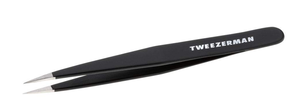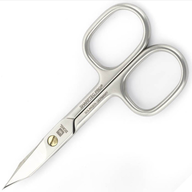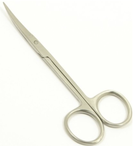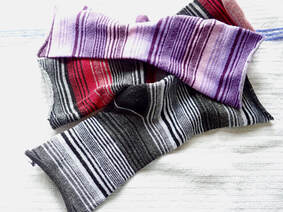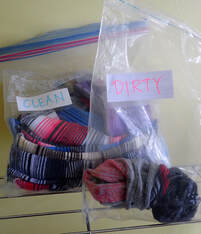Destring 101: Getting Started
1. Prepare Your Destringing Kit
Suggested items to include in destringing kit:
|
Vetericyn Plus All Animal Wound and Skin Care.
Safe and effective for cleaning, softening string and skin for removal, and disinfecting. (Can be ordered from Amazon, please check for bird photo on label that indicates it's bird-safe) For ease of transportation and use, it is helpful to decant it into a smaller spray bottle. |
Bag of grain to attract pigeons,
for example, wheat, brown rice or raw, unsalted, hulled sunflower seeds.
Avoid round seeds like millet as they roll and make it hard to direct the pigeons.
for example, wheat, brown rice or raw, unsalted, hulled sunflower seeds.
Avoid round seeds like millet as they roll and make it hard to direct the pigeons.
Antibacterial wet wipes & Small towel:
Place small towel directly on the ground and lay antibacterial wet wipe on towel.
This serves as a clean, safe area to lay tools during destringing in order to keep them
clean and accessible.
Wet wipes are also useful for cleaning tools and hands.
Available online or at any drugstore.
Place small towel directly on the ground and lay antibacterial wet wipe on towel.
This serves as a clean, safe area to lay tools during destringing in order to keep them
clean and accessible.
Wet wipes are also useful for cleaning tools and hands.
Available online or at any drugstore.
Some of the other items brought along and used during destringing,
depending upon individual preferences:
hand sanitizer
water spray bottle
thermos with warm water + epsom salts for foot soaking
seam ripper for cutting thread
pet carrier in case pigeon needs transport to vet or home for treatment
depending upon individual preferences:
hand sanitizer
water spray bottle
thermos with warm water + epsom salts for foot soaking
seam ripper for cutting thread
pet carrier in case pigeon needs transport to vet or home for treatment
2. Finding Pigeons
Perhaps you already know where there are stringfoot pigeons in your area
in need of assistance.
If not, several possibilities to help you find pigeons in need are:
● Check the Flock Maps
● Ask for advice on one of the facebook groups
● Go out scouting: pigeon flocks can often be found near large grocery stores, and at BART stations or other public transportation hubs.
in need of assistance.
If not, several possibilities to help you find pigeons in need are:
● Check the Flock Maps
● Ask for advice on one of the facebook groups
● Go out scouting: pigeon flocks can often be found near large grocery stores, and at BART stations or other public transportation hubs.
3. Catching Pigeons
One of the most challenging aspects of destringing for beginners can be catching pigeons.
Some possibilities to help you gain catching skills are:
● Attend a destringing session with experienced destringers, who can give you advice and coaching. Announcements for these events appear on the facebook group pages.
● Watch the video tutorials and practice at home - you can use a shoe as a pigeon substitute!
Some possibilities to help you gain catching skills are:
● Attend a destringing session with experienced destringers, who can give you advice and coaching. Announcements for these events appear on the facebook group pages.
● Watch the video tutorials and practice at home - you can use a shoe as a pigeon substitute!
4. Handling Pigeons
Ideally, you will be destringing with a partner, and one person will hold the bird while the other destrings.
When you are the one handling a pigeon for destringing, it is crucial to consider their comfort, well-being, and anxiety level.
These suggestions from one of our members may help guide you in handling the pigeon with care:
When you are the one handling a pigeon for destringing, it is crucial to consider their comfort, well-being, and anxiety level.
These suggestions from one of our members may help guide you in handling the pigeon with care:
Some thoughts on holding birds during destringing.
We can call them the 4T's of Holding:
1. Tightness and position of the sock and hands. Sock should be snug enough to secure wings, but not construct breathing. Hands should firmly but lightly cup the wings. No pressure at all on the crop (digestive area around neck).
2. Tilt. Hold the bird upright to support normal blood flow. This can also prevent unnecessary neck strain that could occur if bird is holding up their own head while being tilted back. If you need to lie them down, just make sure their neck is gently supported.
3. Temperature. Consider the weather and position of the sun. If it's cold outside, try to find a nice warm sunny spot. If it's warm, shade the bird and notice if the sock and/or your hands are excessively warm.
4. Tell. As the holder, pay attention to the bird's movements and heart beat. If their breathing changes or they start to struggle, let the destringer know. The bird might be in pain, have their break trapped in the sock, or be able to see out of the sock. Adjust and give the bird a little break from destringing if it seems painful.
We can call them the 4T's of Holding:
1. Tightness and position of the sock and hands. Sock should be snug enough to secure wings, but not construct breathing. Hands should firmly but lightly cup the wings. No pressure at all on the crop (digestive area around neck).
2. Tilt. Hold the bird upright to support normal blood flow. This can also prevent unnecessary neck strain that could occur if bird is holding up their own head while being tilted back. If you need to lie them down, just make sure their neck is gently supported.
3. Temperature. Consider the weather and position of the sun. If it's cold outside, try to find a nice warm sunny spot. If it's warm, shade the bird and notice if the sock and/or your hands are excessively warm.
4. Tell. As the holder, pay attention to the bird's movements and heart beat. If their breathing changes or they start to struggle, let the destringer know. The bird might be in pain, have their break trapped in the sock, or be able to see out of the sock. Adjust and give the bird a little break from destringing if it seems painful.
5. Destringing Pigeons
The focus of our work is this stage: destringing pigeons.
Ideally, you will be destringing with a partner, and one person will hold the bird while the other destrings.
Destringing requires the proper tools (see #1 above), patience, and close observation.
Some ways to gain skills in destringing are:
● Attend a destringing session with experienced destringers, who can give you advice and coaching.
This provides an opportunity to see the process and some of the challenges you will face.
Announcements for these events appear on the facebook group pages and
on our "News and Events" page.
● Watch the video tutorials.
This likewise provides an opportunity to see the process and some of the challenges you will face.
Ideally, you will be destringing with a partner, and one person will hold the bird while the other destrings.
Destringing requires the proper tools (see #1 above), patience, and close observation.
Some ways to gain skills in destringing are:
● Attend a destringing session with experienced destringers, who can give you advice and coaching.
This provides an opportunity to see the process and some of the challenges you will face.
Announcements for these events appear on the facebook group pages and
on our "News and Events" page.
● Watch the video tutorials.
This likewise provides an opportunity to see the process and some of the challenges you will face.
6. Is Vet Care Needed?
One of the most challenging aspects of destringing is deciding when the
bird needs more help than you can offer, and taking him/her for veterinary care.
This decision can be complicated by the fact that some vets may suggest euthanasia if a
pigeon requires a complex or costly veterinary procedure or extended care.
Therefore, your choice of how to proceed may be influenced by the availability of
pigeon-friendly vets or wildlife rescues in your area.
We recommend that you investigate your local options in advance;
if you encounter a pigeon in need of help
you should already have a good idea of how to get this help.
The more you destring, the better you will be able to gauge the seriousness of
a bird's condition. Destringing with experienced destringers will also help you
learn to recognize signs that a bird needs infection control or pain relief.
Ultimately, however, this will be your decision.
Prepare yourself to make it wisely by gathering information and experience.
bird needs more help than you can offer, and taking him/her for veterinary care.
This decision can be complicated by the fact that some vets may suggest euthanasia if a
pigeon requires a complex or costly veterinary procedure or extended care.
Therefore, your choice of how to proceed may be influenced by the availability of
pigeon-friendly vets or wildlife rescues in your area.
We recommend that you investigate your local options in advance;
if you encounter a pigeon in need of help
you should already have a good idea of how to get this help.
The more you destring, the better you will be able to gauge the seriousness of
a bird's condition. Destringing with experienced destringers will also help you
learn to recognize signs that a bird needs infection control or pain relief.
Ultimately, however, this will be your decision.
Prepare yourself to make it wisely by gathering information and experience.
7. Releasing the Pigeon
After destringing, the pigeon should be released back into their flock.
Pigeons are monogamous and the bird you have taken care of likely has a mate waiting.
We will often throw out a bit of seed to attract the pigeon's flockmates before
release, so that the pigeon can immediately and easily see and rejoin his/her flock.
Take extra care that you have full control of the pigeon when removing the sock.
It would be extremely dangerous for the bird to get free while still entangled in the sock.
Before releasing the pigeon, take the time to look around and
be sure the setting is safe. Release the pigeon away from cars, people,
or any other potential hazards, and also ensure that there isn't anything that may startle the
bird into a dangerous situation.
Released!
Thank you for saving this pigeon from a life of discomfort and pain.
Pigeons are monogamous and the bird you have taken care of likely has a mate waiting.
We will often throw out a bit of seed to attract the pigeon's flockmates before
release, so that the pigeon can immediately and easily see and rejoin his/her flock.
Take extra care that you have full control of the pigeon when removing the sock.
It would be extremely dangerous for the bird to get free while still entangled in the sock.
Before releasing the pigeon, take the time to look around and
be sure the setting is safe. Release the pigeon away from cars, people,
or any other potential hazards, and also ensure that there isn't anything that may startle the
bird into a dangerous situation.
Released!
Thank you for saving this pigeon from a life of discomfort and pain.



